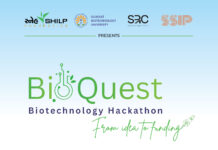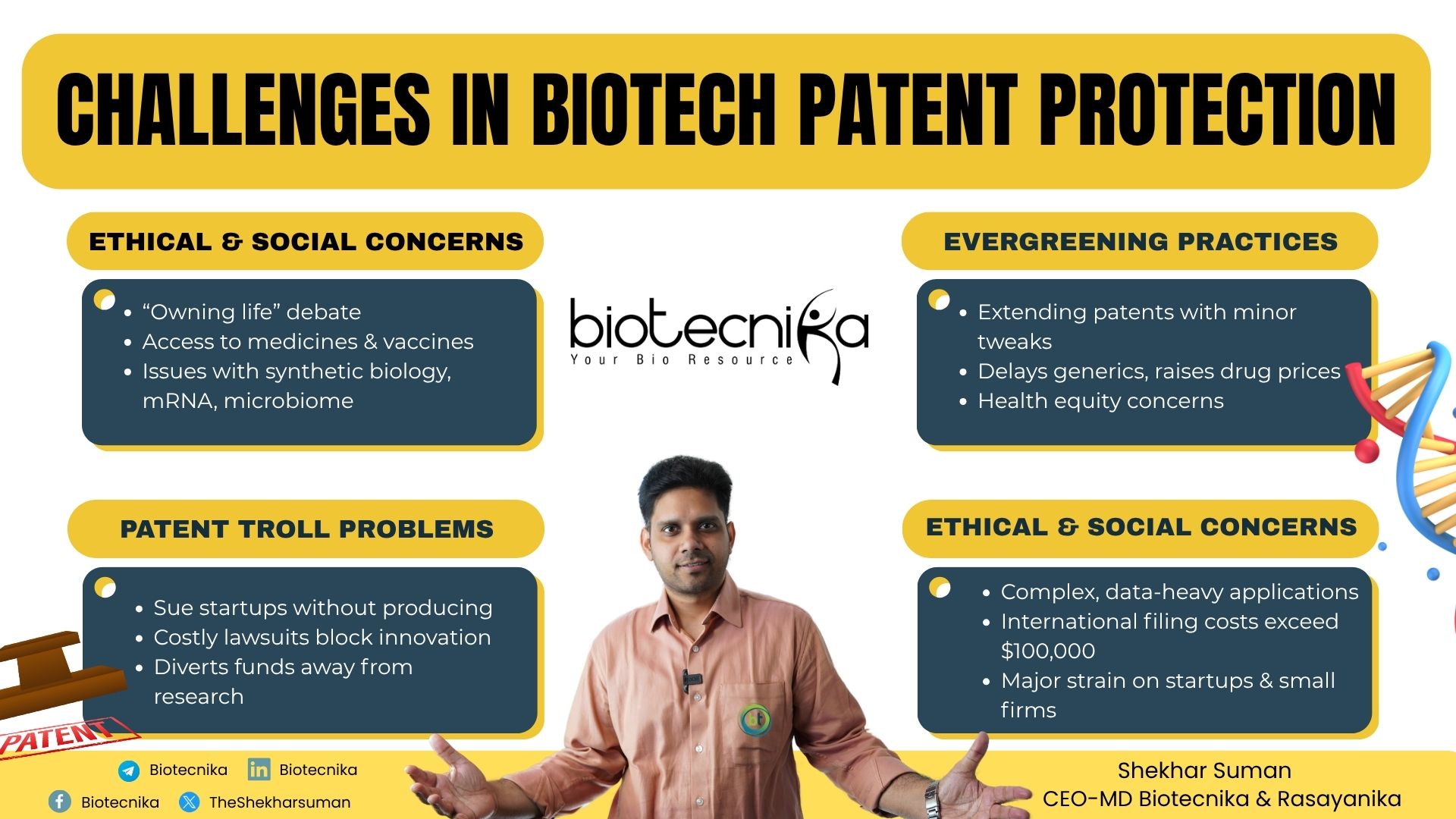Patents in Biotechnology: How Biotech Innovations Are Legally Secured
Biotechnology has revolutionized medicine, agriculture, environmental science, and industrial processes. Patents in biotechnology have played a crucial role in protecting these innovations, fostering further advancements. Be it from genetically engineered crops and life-saving biologics to CRISPR gene-editing tools and personalized therapies, biotech innovations are often the result of years of research, significant financial investment, and high technical expertise.
But what ensures that these inventions are not misused or copied by others?
Well, the answer lies in “patents”, a key tool for protecting intellectual property (IP) in biotechnology.
In this article, we will explore how biotech innovations are protected through patents, what makes them patentable, the complexities involved, and the actual challenges innovators face.
Why Do We Need Patents in Biotechnology?
Bringing a new biotech product to market is not an easy task. It requires more than a billion dollars and around 10 to 15 years to develop something like a biologic drug. And if not protected, anyone could copy that invention once it is made public. This leaves the original innovators with no way to recover their investment or even fund further research.
That’s where the patents come into play. A patent makes sure to grant all the exclusive rights only to the inventors. This allows the innovator to hold the rights of making, using, selling, or licensing their inventions for the next 20 years. This limited period of exclusivity is the innovator’s fair chance to earn back their costs, while also encouraging new discoveries. This will eventually benefit everyone once the patent expires and enters the public domain.
What Can Be Patented in Biotech?
Well, you must have asked this question many times with all the contrary and common misconceptions around it. Let’s make it clear today. Not all biotechnological discoveries are patentable. An invention must qualify these three key criteria to get patented:
-
- Novelty: As an inventor, make sure your invention is new and is not previously known or published anywhere in the world.
- Inventive Step (Non-obviousness): The invention should not be something that any skilled biotech professional could easily figure out. It must show a real creative step forward.
- Industrial Applicability: The invention should have a practical use in industry. In other words, it must be something that can be applied to practical biotech processes or products.
In biotech, the following are typically considered for patent protection:
a. Genetically Modified Organisms (GMOs)
Microbes that are used for industrial purposes, like bacteria engineered to produce insulin, can be patented. Similarly, certain genetically modified crops, such as Bt cotton and Golden Rice, may also qualify for patent protection in some countries.
b. Biological Materials
Genetic material such as DNA sequences, proteins, enzymes, and monoclonal antibodies can be patented if they are isolated and proven useful. These patent rules may vary depending on the country.
c. Processes and Methods
You can patent techniques like CRISPR gene editing, fermentation methods, or advanced diagnostic tests.
d. Therapeutic Products
Often, vaccines (e.g., mRNA COVID-19 vaccines by Pfizer/BioNTech or Moderna), biosimilars, and biopharmaceuticals are always patented in the biotech industry.
Complexity of Patent Eligibility in Biotech
Patents in Biotechnology can be tricky because they are at the crossroads of law, science, and ethics. For an invention to be patentable, it should involve clear human effort and innovation. It’s not just the discovery of something that already exists in nature. There are also moral and ethical boundaries, especially when it comes to patenting life itself.
-
- Human beings at any stage of development (most jurisdictions)
- Naturally occurring DNA sequences, unless isolated and with proven use
E.g.: Myriad Genetics case in the U.S (2013)
The Supreme Court of US decided that natural genes, even if they are taken out of the body, cannot be patented. But if scientists create a new version of it in the lab, the one we call complementary DNA (cDNA), that can be patented.
-
- Discoveries or without utility (e.g., finding a gene without therapeutic application).
- Traditional knowledge or naturally occurring herbs without innovative processing.
Delving into biotech, here is a table of Patents in Biotechnology explaining what is patentable in India. The table is based on the patent guidelines of India. The list will help understand the exploration of patents.
| Patentable subject matter | Non-patentable subject matter |
| Genetically modified microorganisms | In vivo diagnostic methods |
| Pharmaceutical compositions / Biotech drugs | Surgical or therapeutic processes |
| Vaccines / Antibodies (engineered) | Cloning of humans or animals |
| In vitro diagnostic kits/biotech tools | Mere discovery of a natural biological process |
| Medical devices (hardware/software-based) | Plants, animals (in whole or parts) |
| Software with technical effect (bioinformatics, etc.) | Traditional knowledge (e.g., turmeric for healing) |
| Fermentation-based protein production | Agricultural or horticultural methods |
Patents in biotechnology in one country may not qualify for patents in another due to these divergent approaches, making a global patent strategy essential.
Global Market and the Importance of International Protection
Biotech does not stop at national borders. It works on a global scale. Every new discovery and product reaches the global market. This means protecting these biotech innovations in only one country is not enough.
To stay competitive and ensure long-term success, biotech companies must have a strong strategy that will safeguard their inventions internationally.
There are many helpful agreements and systems in the field of Patents in Biotechnology that support inventors in obtaining patent protection in different countries, making the whole process smoother and more efficient.
-
Patent Cooperation Treaty (PCT):
This treaty makes it easier for inventors to apply for patents in many countries at once, instead of filing separate applications everywhere. They can submit a single international application to start the process.
Later, this application is reviewed in each country or region, where it must meet local rules and requirements before the patent is granted.
-
European Patent Convention (EPC):
The European Patent Convention (EPC) makes it easier to protect biotech inventions across Europe. Instead of filing separate patent applications in each country, inventors can submit just one application to the European Patent Office (EPO). If approved, this single application can give patent rights in up to 38 European countries, saving both time and effort.
-
Agreement on Trade-Related Aspects of Intellectual Property Rights (TRIPS Agreement – WTO):
The TRIPS Agreement, managed by the World Trade Organization (WTO), sets the basic rules that all member countries must follow to protect intellectual property.
This agreement helps bring uniformity to patent laws across the world, making the system more stable and predictable. For biotechnology, it means inventors have a clearer and fairer path to protect their innovations internationally.
Despite the availability of international instruments, patent laws continue to vary significantly across different jurisdictions. These disparities can have a profound impact on the scope and enforceability of biotech patents.
-
-
United States vs. India Patents in Biotechnology:
The United States has historically offered broader patent protection for biotechnological inventions compared to India. However, recent rulings such as the Myriad and Mayo decisions have introduced certain limitations to this protection in the U.S.
-
In contrast, while India grants patents for biotechnological processes, the patentability of gene or cell-based products is contingent upon demonstrating significant human intervention and technical application
-
-
European Union Restrictions:
The European Union often takes a more restrictive approach to biotech patents, particularly when moral or ethical considerations are raised. This can result in stricter scrutiny of patent applications and may lead to the denial of patents on certain types of biotechnological inventions.
-
-
-
India’s Approach to Biotechnological Products:
India’s patent laws permit patents on biotechnological processes, but are more cautious regarding gene or cell-based products. To be patentable, such products generally need to demonstrate substantial human intervention and practical technical use, ensuring that the invention is more than a mere discovery of a naturally occurring substance.
-
Patent Strategies in Patents in Biotechnology
Biotech innovators often use a “patent thicket” strategy, filing multiple patents around a single innovation. For instance:
- Core patent on the main innovation (e.g., the DNA sequence)
- Secondary patents on delivery mechanisms, formulations, and dosage forms
- Process patents for manufacturing methods
- Use patents for new therapeutic indications
Example:
One of the best-selling biologics in history, Humira (adalimumab) was protected by a web of over 100 patents: covering the molecule, formulations, methods of treatment, and manufacturing processes. These “patent thickets” delayed biosimilar entry until 2023 in the U.S., ensuring billions in revenue..
Challenges in Patents in Biotechnology
a. Ethical and Social Concerns
Critics argue that patenting genes or life forms is akin to “owning life,” raising moral and accessibility issues. This is especially significant for patents on essential medicines and vaccines.
Also, emerging areas like synthetic biology, mRNA platforms, and microbiome therapies pose new questions about what qualifies as patentable subject matter.
b. Patent Trolls and Litigation
Biotech startups often face problems because of so-called “patent trolls.” These are companies that don’t create products but instead buy up patents just to file lawsuits. They use complicated legal wording to demand money from small businesses.
As a result, startups end up spending huge amounts on legal battles instead of investing in research. In many cases, the fear of being sued stops them from working on new ideas and biotech innovations. In short, patent trolls slow down innovation and make it harder for biotech startups to grow.
c. Evergreening
Some pharmaceutical companies try to extend their patent rights by making only small changes to an existing drug. This practice, known as evergreening, often delays the entry of cheaper generic medicines and biosimilars into the market.
As a result, patients face higher drug prices and healthcare systems carry a heavier financial burden. These tactics focus more on keeping market control than on creating true innovation, raising serious ethical concerns. The impact is felt most in developing countries, where access to affordable medicines is already limited.
d. High Patent Filing and Maintenance Costs
Biotech patent applications are often complex. It requires detailed scientific data and expert drafting. The costs can exceed $100,000 for international coverage.
Alternatives to Patents: Complementary Patents in Biotechnology Strategies
While patents are dominant, they are not the only protection tools in biotech. Others include:
- Trade Secrets: Especially for cell culture processes or vaccine manufacturing techniques (e.g., mRNA vaccine delivery systems).
- Regulatory Exclusivity: Market protection offered by drug regulatory bodies even without a patent (e.g., data exclusivity for biologics under U.S. FDA rules).
- Design and Trademark Protection: For biotech devices or brands (e.g., diagnostic kits or biotech company logos).
The Future: Synthetic Biology and AI in Biotech
Emerging fields like synthetic biology and AI-driven drug discovery bring fresh challenges. For instance:
- Who owns a molecule discovered by an AI algorithm?
- Can an entirely synthetic cell be patented?
Patent laws worldwide are playing catch-up with these fast-paced advances, and legal reform may be necessary to ensure robust but ethical protection mechanisms.
Key Takeaways of Patents in Biotechnology
In the world of Biotech, Patents are not just a piece of legal documents. They are the most valuable business tools, helping companies secure funding, protect their biotech innovations, and stay ahead in the field. However, this protection has to strike a balance and encourage new ideas. It has to make sure that essential products like medicines and crops are still accessible to the public.
Today, Patents in Biotechnology are not a simple box-ticking exercise. It’s an ongoing strategy that is based on science, law, and public health needs across the world. For researchers, investors, and policymakers, being part of and understanding these changing dynamics is key to unlocking the mysteries of biotech.

































It amazing faculty for the next generation any time it provides good life and I’ll be happy to join with you guys